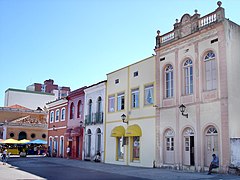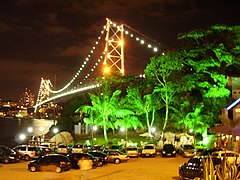Florianopolis
Florianópolis is the capital of the state of Santa Catarina, in the southern region of Brazil, named after former president Floriano Peixoto, replacing its previous name "Nossa Senhora do Desterro" (Our Lady of Banishment). The city is known because its inhabitants have a high quality of life, being the Brazilian capital with the highest score in the Human Development Index (IDH), calculated by the UNDP, of the United Nations. The economy is based on Information Technology, tourism and services.
Florianópolis has 100 beaches and a center for nautical activities. The American newspaper The New York Times stated in 2009 that "Florianópolis was the destination of the year", while Newsweek considered that the municipality was "one of the 10 most dynamic cities in the world" in 2006. It is one of the safest capitals in Brazil.
History of their names
Initially the Spaniards called it Santa Catalina, like the island where its historic center is located, later it received the name in Spanish and Portuguese of Santa Catharina or Santa Catarina and officially the name of Our Lady of Exile, during the XIX century At the beginning of the XX century, Brazilians called it Desterro. Since the end of the XX century, she has often been colloquially called Floripa and nicknamed &# 34;Island of Magic" the latter is said to be due to the fact that several alchemists would have taken refuge there during the colonial period, both Spanish and Portuguese.
Geographical location and characteristics
The city of Florianópolis is located to the east of the state of Santa Catarina and is bathed by the Atlantic Ocean. A large part of Florianópolis (97.23%) is located on the island of Santa Catarina, where there are 42 beaches, many in a virgin state and little known by tourists. There are also two large lagoons: Lagoa da Conceição (salt water lagoon) and Lagoa do Peri (fresh water lagoon).
Florianópolis is the second Brazilian capital, after Brasilia, with the best Human Development Index (IDH) (0.897), according to the UN.
The metropolitan region of Florianópolis, made up mainly of the municipalities of São José, Palhoça, Santo Amaro da Imperatriz and Biguaçu, had about 1.1 million inhabitants in 2016.
Tourism is one of the main activities of the city, which is visited every year by millions of tourists from Brazil and nearby countries, especially Argentina, Uruguay, Paraguay and Chile.
Climate
Florianópolis presents the climatic characteristics inherent to the south-Brazilian coast. The seasons of the year are well defined, summer and winter well defined, with autumn and spring having similar characteristics.
The average of the maximums of the hottest month varies from 26 °C to 31 °C and the average of the minimums of the coldest month, from 7.5 °C to 12 °C. It is the fourth coldest capital in the country, after Curitiba, Porto Alegre and São Paulo.
The average annual temperature is around 21 °C. Precipitation is significant and well distributed throughout the year. The normal annual precipitation for the period 1911-1984 was 1521 mm. There is no dry season, with summer generally being the season with the highest rainfall index (Hermann et al, 1986). High rainfall occurs from January to March, with an average of 160 mm per month, while from April to December there is little variation, with an average of around 100 mm per month. The lowest values occur from June to August.
The lowest temperature recorded in Florianópolis was 0.6 °C on June 13, 2016
| Month | Ene. | Feb. | Mar. | Open up. | May. | Jun. | Jul. | Ago. | Sep. | Oct. | Nov. | Dec. | Annual |
|---|---|---|---|---|---|---|---|---|---|---|---|---|---|
| Temp. max. abs. (°C) | 38.2 | 38.8 | 33.1 | 31.7 | 30.6 | 30.0 | 31.8 | 31.1 | 28.8 | 29.9 | 33.0 | 35.6 | 38.8 |
| Average temperature (°C) | 28.0 | 28.4 | 27.5 | 25.4 | 23.0 | 20.9 | 20.4 | 20.7 | 21.2 | 22.9 | 24.8 | 26.6 | 24.2 |
| Average temperature (°C) | 24.2 | 24.6 | 23.6 | 21.1 | 18.9 | 16.7 | 16.5 | 16.9 | 17.9 | 19.6 | 21.3 | 23.0 | 20.4 |
| Temp. medium (°C) | 21.4 | 21.8 | 20.7 | 18.3 | 15.6 | 13.4 | 13.3 | 14.0 | 15.1 | 16.9 | 18.6 | 20.3 | 17.5 |
| Temp. min. abs. (°C) | 14.6 | 15.4 | 10.2 | 7.7 | 5.3 | 2.2 | 1.5 | 4.0 | 0.7 | 9.1 | 9.4 | 12.5 | 0.7 |
| Total precipitation (mm) | 162.7 | 196.9 | 173.0 | 92.8 | 96.9 | 89.5 | 99.5 | 95.3 | 134.2 | 109.8 | 130.2 | 137.0 | 1517.8 |
| Precipitation days (≥ 1.0 mm) | 12 | 13 | 12 | 8 | 7 | 8 | 8 | 8 | 11 | 11 | 11 | 11 | 120 |
| Hours of sun | 201.1 | 185.1 | 194.1 | 195.1 | 185.0 | 163.2 | 169.5 | 152.6 | 129.4 | 159.1 | 173.9 | 188.7 | 2096.8 |
| Relative humidity (%) | 81 | 82 | 82 | 82 | 83 | 83 | 84 | 83 | 83 | 81 | 80 | 80 | 82 |
| Source: INMET | |||||||||||||
Beaches
Florianópolis was considered to have 42 beaches, this being one of the slogans of the municipality for decades. Commissioned by the IPUF (Institute of Urban Planning of Florianópolis), a complete analysis of the beaches of the capital of Santa Catarina was carried out for the first time. More than 100 beaches were mapped. As the objective of the work was toponymic, to comply with the municipal law that determines the signposting of all the beaches, more than a dozen were left out that, being so unknown, did not have a name.
Santa Catalina Island is long and narrow in shape, averaging 54 km long and 18 km wide. With a fairly indented coastline, it has several points, islands, bays and lagoons. The island is located parallel to the mainland, separated by a narrow channel.
Its relief is formed by mountainous and discontinuous ridges, serving as a watershed for the island. Altitudes vary between 400 and 532 meters. The highest point on the island is the "Morro do Ribeirão", 532 meters high.
Wide plains arise parallel to the mountains, in an easterly direction and in the northwestern portion of the island. In the eastern part of the island, there are dunes formed by the action of the wind.
Administrative division
The city is divided into 12 districts: Sede, Barra da Lagoa, Cachoeira do Bom Jesus, Campeche, Canasvieiras, Ingleses do Rio Vermelho, Lagoa da Conceição, Pântano do Sul, Ratones, Ribeirão da Ilha, Santo Antônio de Lisboa and São João do Rio Vermelho.
Airport
The city's airport is the Hercílio Luz International Airport.
Tourism
The island has several beaches of tourist interest and a wide range of accommodation. Some of the most visited are Jurerê Internacional, Canasvieiras and Ingleses in the north of the island.
Map
Center of the island and mainland part of the city
- Centre, Public offices, trade
- Trindade, Headquarters of the central campus of the Federal University of Santa Catarina, the state's public university.
- Pantanal, Córrego Grande, Carvoeira, neighborhoods adjacent to the university campus, offer rentals of bedrooms or departments for students of the Federal University.
East of the island
- Barra da Lagoa, located in the mouth of the coastal lagoon in the sea
- Playa Mozambique, located next to beach da bar da Lagoa, surfing practice, forest and dunes to enter
- Lagoa da Conceição, calm water, boat trips through the coastal lagoon, active nightlife
- Playa Mole, young people, surfing practice
- Playa Galheta, beautiful landscape, nature reserve, nudist/naturist beach
- Joaquina Beach, young people, international surf circuit, sandboard practice
North of the island
- Cachoeira do Bom Jesus, warm water
- Canasvieiras, warm water, boat trips
- English do Rio Vermelho, strong waves
- Ratons, villa without beach
- São João do Rio Vermelho, villa
- Ponta das Canas, warm water, fishing
- Traditional Jurerê, warm water
- International Jurerê, warm water, mansions, famous
West of the island
- Santo Antônio de Lisboa, gastronomy, sea fruits
South of the island
- Campeche, cold water, strong waves
- Pantano do Sul, fishing village
- Ribeirão da Ilha, near the international airport
Twinned cities
Images
Contenido relacionado
Cross port
Prague
Hato Mayor Province
Black forest
Venice















